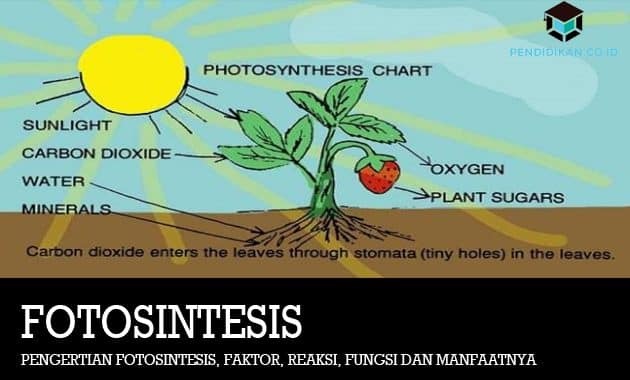Definition of Photosynthesis, Factors, Reactions, Functions and Benefits
Education. Co. ID - this time we will discuss photosynthesis, a full explanation of this photosynthesis will be described as follows:

Definition of Photosynthesis
Photosynthesis is a process of making food carried out by a plant that uses water (H2O), carbon dioxide (CO2) by requiring the help of energy, namely sunlight to produce a food substance and also Oxygen (O2). Or another definition of photosynthesis is a process of processing or also the formation of organic matter is like carbohydrates that come from water and also carbon dioxide with the help of light energy sun.
This photosynthesis process can be carried out by green plants, algae and also bacteria that have chlorophyll (green leaf substance) during the day. What happens during the day? Because in order to carry out the process of photosynthesis, plants need sunlight energy. These plants can absorb sunlight energy because they have a pigment called chlorophyll, this pigment gives the green color of plant leaves. Chlorophyll is present in organelles called chloroplasts. Generally, the energy from photosynthesis is produced in the leaves, but it can also occur in organs or other plant parts that have green substances.
Kinds of Photosynthetic Reaction
Generally, most of the occurrence of a photosynthesis process that takes place in the chloroplasts requires the element of sunlight to be able to make glucose. However, there is another process of photosynthesis that does not use light.
So the photosynthetic reaction itself is divided into light reactions and dark reactions. full explanation as follows:
1. Bright Reaction
This light reaction is a photosynthetic reaction that requires the help of sunlight. Usually this reaction will take place in an open space that is exposed to sunlight directly live. The light reactions take place in the thylakoid membrane in the chloroplast space. In this reaction, the chlorophyll will serve as an absorber of sunlight which is used to convert water molecules into oxygen and hydrogen in the form of ATP. This light reaction is known as photolysis.
2. Dark Reaction
If the light reaction is very dependent on the intensity of light, then the dark reaction is the opposite. In this dark reaction means that it does not depend on sunlight, but the dark reaction will not occur if the plant does not carry out the light reaction first. If the light reaction takes place in the thylakoid membrane, the dark reaction takes place in the stroma of the chloroplast. The process that occurs in the dark reaction is very complex, just like the light reaction and whatever the main purpose of the dark reaction is to convert the carbon dioxide into glucose.
Factors affecting photosynthesis
Below are the factors that can affect the process of photosynthesis, including the following:
1. Availability of water
Lack of water content can cause the leaves to wither and the stomata on the leaves to close, so this will reduce the absorption of carbon dioxide.
2. Carbon dioxide concentration
The concentration of carbon dioxide can also affect a process of photosynthesis, due to: because, the higher the concentration of carbon dioxide, the more it will increase the rate of photosynthesis.
3. Sunlight intensity
The intensity of sunlight can also affect the process of photosynthesis, because the energy of sunlight is needed by plants in carrying out this process. Because the higher the intensity of sunlight, the more energy is formed so that it can accelerate the process of photosynthesis. However, if the light intensity is too high, it can cause damage to chlorophyll in plants.
Functions or benefits of photosynthesis
The main function of photosynthesis is to be able to produce food substances in the form of glucose / sugar. This is because glucose is the main ingredient in the manufacture of other food substances such as fat and protein in plants. These substances will later become food for humans and animals.
Another function of photosynthesis is that it can clean the air from pollution by reducing carbon dioxide levels in the air because carbon dioxide is the material needed by green plants to carry out photosynthesis. As a result, in addition to food substances, oxygen will also be produced which is very necessary for the survival of humans and animals on earth.
The ability of plants to carry out photosynthesis during their lives makes the remains of plants that lived in the past buried by the ground for millions of years and will become coal that can be used by humans, namely as a source of energy energy.
Now that's an explanation of the Definition of Photosynthesis, Factors, Functions and Their Benefits, hopefully what is described can be useful for you. thank you
See AlsoUnderstanding Gopher, Functions, How it Works and Its Advantages
See AlsoUnderstanding Social Stratification, Processes, Factors, Types, and Functions
See AlsoUnderstanding MoUs, Characteristics, Objectives, Types and Benefits According to Experts
